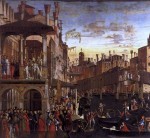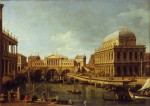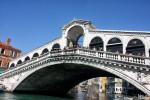 The Rialto is by far the oldest and most famous of the four bridges that span the Grand Canal of Venice. Until the 19th century, it was the only bridge across the canal. The first iteration was built out of wood in 1255. The two sides of the bridge inclined upwards towards a central platform that could be removed to allow for the passage of taller ships. It was called the Bridge of Coin then, because of the toll for pedestrian passage. In 1458 shops were added to the sides and it was renamed the Rialto Bridge. With the popular Rialto market on the eastern bank and the bridge being the only non-nautical means to cross to Grand Canal, it had to withstand an enormous amount of traffic. It collapsed twice from the weight of crowds and had to be rebuilt. Another time the crowds viewing the passage of the spectacular 1,500-people-strong cortège of Holy Roman Emperor Frederick III in 1468 put so much pressure on the iron railings that they collapsed, dozens of spectators fell into the canal and died.
The Rialto is by far the oldest and most famous of the four bridges that span the Grand Canal of Venice. Until the 19th century, it was the only bridge across the canal. The first iteration was built out of wood in 1255. The two sides of the bridge inclined upwards towards a central platform that could be removed to allow for the passage of taller ships. It was called the Bridge of Coin then, because of the toll for pedestrian passage. In 1458 shops were added to the sides and it was renamed the Rialto Bridge. With the popular Rialto market on the eastern bank and the bridge being the only non-nautical means to cross to Grand Canal, it had to withstand an enormous amount of traffic. It collapsed twice from the weight of crowds and had to be rebuilt. Another time the crowds viewing the passage of the spectacular 1,500-people-strong cortège of Holy Roman Emperor Frederick III in 1468 put so much pressure on the iron railings that they collapsed, dozens of spectators fell into the canal and died.
 In the 16th century, Venetian authorities began to explore the possibility of replacing the wooden bridge with a stone bridge. It took almost the whole century to go from concept to execution. In 1551, top architects were invited to submit stone bridge ideas, but none of the submissions were deemed acceptable because they employed multiple Roman-style arches which would be a problem for boat traffic. The great Venetian architect Andrea Palladio envisioned a three-arch bridge topped with a monumental temple-like structure that would have dwarfed the mighty Mississip’. Finally architect and engineer Antonio da Ponte designed a single-span stone bridge very similar in shape, elevation and structure to the wooden bridge. Construction began in 1588 and was completed in 1591.
In the 16th century, Venetian authorities began to explore the possibility of replacing the wooden bridge with a stone bridge. It took almost the whole century to go from concept to execution. In 1551, top architects were invited to submit stone bridge ideas, but none of the submissions were deemed acceptable because they employed multiple Roman-style arches which would be a problem for boat traffic. The great Venetian architect Andrea Palladio envisioned a three-arch bridge topped with a monumental temple-like structure that would have dwarfed the mighty Mississip’. Finally architect and engineer Antonio da Ponte designed a single-span stone bridge very similar in shape, elevation and structure to the wooden bridge. Construction began in 1588 and was completed in 1591.
 Legend has it that Antonio da Ponte paid dearly for having created an icon of La Serenissima. When the bridge was almost done, the Devil himself approached the architect and demanded an offering of the first soul to cross the bridge. If da Ponte refused, Satan would forever prevent the completion of the Rialto Bridge. Unable to refuse, he tried to outsmart the Devil, arranging for a rooster to be the first living being to cross the bridge. The Devil was furious. He promised to punish the architect dearly, and so he did. In disguise, he went to da Ponte’s house and told his pregnant wife that her husband was waiting for her on the other side of the bridge. She ran across and unwittingly doomed the life she was carrying. The baby was stillborn. For years the baby’s spirit was said to haunt the Rialto until a kindly gondolier finally helped him rest in peace.
Legend has it that Antonio da Ponte paid dearly for having created an icon of La Serenissima. When the bridge was almost done, the Devil himself approached the architect and demanded an offering of the first soul to cross the bridge. If da Ponte refused, Satan would forever prevent the completion of the Rialto Bridge. Unable to refuse, he tried to outsmart the Devil, arranging for a rooster to be the first living being to cross the bridge. The Devil was furious. He promised to punish the architect dearly, and so he did. In disguise, he went to da Ponte’s house and told his pregnant wife that her husband was waiting for her on the other side of the bridge. She ran across and unwittingly doomed the life she was carrying. The baby was stillborn. For years the baby’s spirit was said to haunt the Rialto until a kindly gondolier finally helped him rest in peace.
The bridge’s design caused some consternation at the time. Without arches, the full weight of the structure was shouldered entirely by the two pylons and foundations and each end. There were grave doubts among some architects, most notably Vincenzo Scamozzi, that the heavy stone bridge could stand without additional supports. And yet, it stood. Over the centuries it was repeatedly altered and repaired. The first major restoration was in 1740, but it stipulated that the arch itself could not be touched. The repairs focused on the stairs, balustrade, colonnade and paving tiles. Later restorations took a similar tack, fixing the peripherals — steps, drainage issues, shops.
 More than 400 years would pass before the Rialto Bridge got a thorough top-to-bottom restoration. That’s a good thing from a historical preservation perspective, because it leaves conservators with a great deal of original material and limits the damage inflicted by well-intentioned but overly invasive interventions.
More than 400 years would pass before the Rialto Bridge got a thorough top-to-bottom restoration. That’s a good thing from a historical preservation perspective, because it leaves conservators with a great deal of original material and limits the damage inflicted by well-intentioned but overly invasive interventions.
The restoration project started in 2011 with an extensive nine-phase preliminary investigation of the bridge: 1) a historical survey analyzing all the different phases of construction and repair over the centuries, 2) a photogrammetric and laser scanning survey of the bridge surface to gather precise measurements, 3) geotechnical drilling into the soil of the bridge foundations, 4) underwater inspection of the foundations, 5) archaeological analysis of the foundation coring samples, 6) monitoring a year’s worth of geological stresses and shifts, 7) a structural survey of the bridge, 8) research and analysis of the bridge’s petrographic materials and state of conservation or decay, and 9) identification of underground utilities.
Armed with reams of hard data, conservators began the hands-on part in May of 2015.
The restoration has systemically treated all of the bridge’s structural elements for the first time in more than 400 years. A team of 25 conservators dismantled the sandstone paving on the central steps and the two exterior ramps for cleaning, while workers relaid the telephone, gas and electric cables powering the bridge’s 24 shops. They strengthened the walls of the arcades and added a further layer of waterproof insulation, as well as new internal sheets to the 700 sq. m of lead sheets covering the roofs.
To protect the northern and southern balustrades from the lagoon’s brackish waters, as well as the thousands of tourists who walk across it each year, the banisters were reinforced using carbon-fibre bandages and duplex stainless steel brackets that resist corrosion. The 364 columns, which presented fractures on their capitals and bases, were also reset in molten lead and some of the cornerstones were completely replaced.
This was all done piecemeal so the bridge was never closed to visitors. Unsightly scaffolding was the worst of it. Shocking everyone who has ever had needed any construction done in Italy, the restoration finished on time (but not on budget, of course) and reusing 99% of the bridge’s materials. The remaining 1% requiring replacement was mostly paving.
The scaffolding is down now, but the official opening will take place in May at the Venice Biennale.